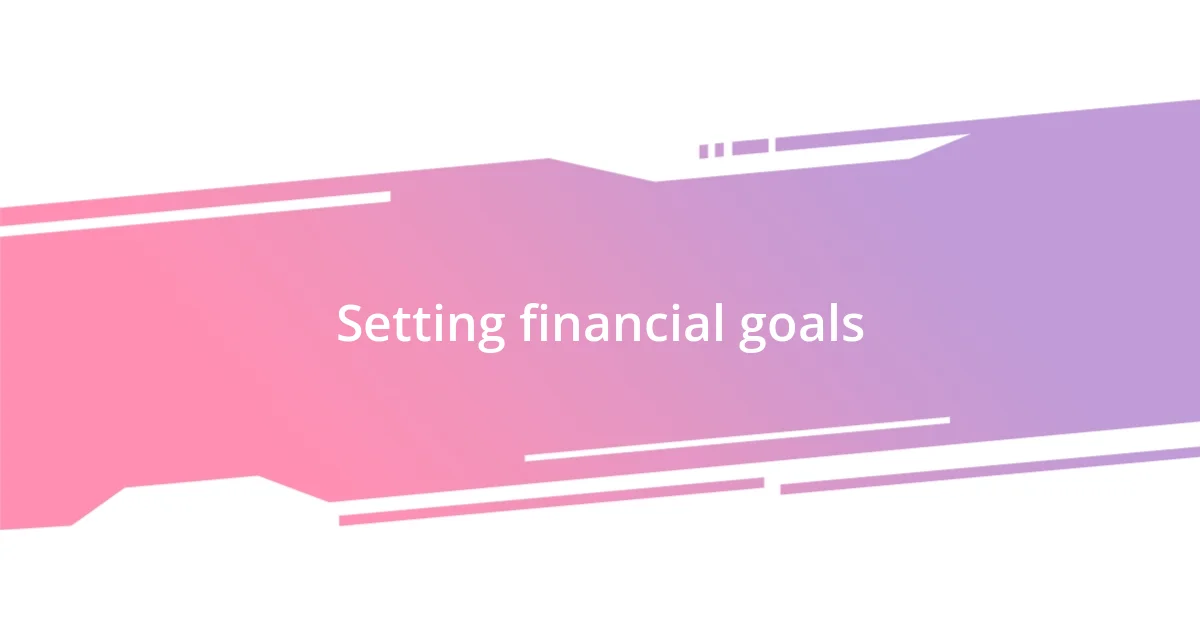Key takeaways:
- Understanding household budgeting involves tracking income and expenses to regain control over financial habits and prioritize spending.
- Setting clear financial goals—short-term, medium-term, and long-term—provides direction and motivation for effective budgeting.
- Regularly evaluating and adjusting the budget based on personal habits and unexpected expenses promotes a balanced approach to spending and saving.

Understanding household budgeting
Understanding household budgeting is more than just tracking expenses; it’s about gaining control over your financial life. I remember the feeling when I first started budgeting; there was this weight lifted off my shoulders as I realized I could indeed manage my money rather than letting it manage me. Isn’t it liberating to take charge of where your dollars go?
A budget is essentially a plan that outlines your income and expenses, giving you a clear picture of your financial situation. I often think of my budget as a roadmap. When I’ve strayed from it, I’ve noticed how quickly my finances can spiral out of control, and it makes me wonder: how can we expect to reach our goals if we don’t have a plan? Having a realistic budget allows us to prioritize our spending and make informed decisions.
Moreover, regularly reviewing your budgeting process can create a deeper understanding of your habits. At times, I’ve been surprised by how much I was spending on seemingly trivial things, like that daily coffee or those impulse online buys. Have you ever taken a close look at your recurring expenses? Identifying these areas can lead to significant savings and a more fulfilling financial future.

Setting financial goals
Setting clear financial goals is crucial for effective budgeting. When I first dove into budgeting, I realized that without specific targets, it felt like wandering aimlessly. You need a vision to guide your decisions. It’s similar to training for a marathon; if I didn’t have that finish line in sight, I wouldn’t have the motivation to lace up my running shoes each morning.
To set those effective financial goals, I recommend considering the following:
- Identify short-term goals (like saving for a vacation).
- Establish medium-term goals (such as building an emergency fund).
- Define long-term goals (like saving for retirement or a home).
- Break down each goal into actionable steps (which helps to maintain focus).
- Regularly reassess your goals to ensure they remain relevant and achievable.
By doing this, I create a sense of purpose around my budget, making the process much more engaging and motivating.

Tracking monthly income
Tracking my monthly income is like setting the foundation for my budgeting structure. I remember when I first gathered all my income sources—my job salary, freelance earnings, and even that occasional side gig. Seeing everything laid out gave me a sense of clarity. Have you ever experienced that moment of realization when you see your total income? It’s not just numbers; it’s the starting point of my financial journey.
To accurately track my monthly income, I categorize it by source, which helps me identify trends over time. For instance, in some months, my freelance work would surge, offering me an unexpected bonus. This pattern has taught me a lot about living within my means. If I hadn’t been tracking my income this way, I might have overestimated my financial stability and made decisions that could have landed me in trouble. Understanding not just how much I make, but also when I receive it, has been a game changer for me.
Using a simple spreadsheet to track my income has been incredibly helpful. I often color-code different income sources, which gives me a visual representation of my earnings. It’s visually appealing and adds a level of engagement to the tracking process. Do you ever find yourself getting lost in numbers? Having that colorful layout keeps me focused and motivated.
| Income Source | Amount |
|---|---|
| Full-time salary | $3,000 |
| Freelance work | $800 |
| Side gig | $200 |

Categorizing household expenses
Categorizing household expenses has been a pivotal part of my budgeting strategy. I remember the first time I sat down to map out my expenses—utilities, groceries, entertainment—you name it. It felt like peeling back layers, discovering just where my money was going. It’s fascinating how often we overlook these details. Have you ever found a subscription lingering unnoticed in your bank statement? That realization can be a wake-up call.
Breaking down expenses into categories gives me clarity and control. For example, I typically separate my fixed expenses, like rent and insurance, from variable ones, like dining out and shopping. This separation makes it easier for me to see where I can cut back if needed. One month, I realized I was spending far too much on takeout. By reorganizing my budget and setting a specific limit, I not only saved money but also discovered the joy of cooking at home. The satisfaction from a homemade meal is truly unmatched, don’t you think?
Lastly, I’ve learned to personalize my categories based on what feels relevant in my life. Maybe for you, it’s travel and experiences, while for me, it leans more toward health and fitness. Adjusting categories to reflect my priorities has allowed me to make informed choices that align with my long-term goals. Imagine the empowerment that comes from knowing your money is working towards the things you value most!

Creating a realistic budget plan
Creating a realistic budget plan starts with setting clear, attainable goals. I recall the first time I drafted my budget—it was ambitious, and, to be honest, a bit unrealistic. I had dreams of saving a certain amount each month while staying within my spending limits, but life has a way of throwing unexpected expenses at you. Have you ever felt that pinch when something unforeseen pops up? It taught me that my budget needed to be flexible. Now, I set specific, achievable targets that genuinely reflect my lifestyle, ensuring I’m not just chasing numbers but embracing a balanced financial approach.
Next, I prioritize my spending based on my needs. I take a good hard look at essentials, like housing and groceries, before considering discretionary expenses. One month, I found myself tempted to buy that shiny gadget everyone was raving about. I paused to reflect—was it a need or just a fleeting desire? By assessing my priorities, I felt empowered to say no, reinforcing the importance of aligning spending with my values.
Lastly, I factor in some fun! Life isn’t just about saving every penny; it’s about enjoying the fruits of my labor as well. I remember the initial shock of allocating a portion of my budget for leisure. But once I did, I found I could indulge in hobbies and experiences without guilt. Have you ever rewarded yourself after a month of disciplined budgeting? It’s a gratifying feeling, one that motivates me to keep my finances on track while living life to the fullest.

Evaluating and adjusting the budget
Evaluating my budget is a vital practice that I revisit regularly, and it often opens my eyes to the fluid nature of my finances. I think back to a particular summer when my energy costs unexpectedly rose due to a heatwave. It made me realize that I needed to reassess my budget mid-cycle rather than waiting for the monthly review. Have you ever found yourself in a similar situation, where external factors prompted a change in your spending? By making adjustments in real-time, I learned to stay proactive rather than reactive.
I’ve developed a habit of tracking my expenses weekly, which I find helps in evaluating whether I’m staying in line with my budget. For instance, during one week, I noticed that my grocery bills were creeping higher than usual. Upon investigating, I discovered that I was buying more prepared items rather than cooking from scratch. So, I adjusted my budget to reflect this spike and resolved to create meal plans that emphasize cooking. Have you ever considered how meal planning can not only save money but also promote healthier eating habits?
Adjustments also involve reflecting on what works best for me. Sometimes, I’ll review my categories and notice that my entertainment budget is a bit too tight. A small adjustment can lead to a richer quality of life—maybe allowing for a night out with friends or a spontaneous movie. That feeling of freedom is remarkable, reminding me that a budget isn’t just about restriction; it’s about enabling the life I want to live. How do you balance between sticking to your budget and allowing for those little joys that keep life vibrant? For me, the key lies in constant evaluation and adaptation.

Tips for staying on track
Staying on track with my budgeting requires a consistent check-in with myself. I’ve found that setting weekly reflections really helps. After a long week, I like to sit down, look over my expenses, and assess how I did. It’s almost like a mini therapy session for my finances! Have you ever taken that moment to reflect on your spending habits? It can be enlightening, showing me what worked and what might need a little more attention.
One simple trick I’ve embraced is using a budgeting app on my phone. It syncs to my accounts and sends me notifications when I’m close to my limits. Just the other day, I received a gentle reminder about my dining out budget, which stopped me from impulsively grabbing lunch with a co-worker. I started to think, “Is that really necessary right now?” This quick check-in helped me stick to my goals without feeling deprived. How do you remind yourself of your financial targets in your daily life?
Additionally, I always keep a small reserve for unexpected joy. Let’s be honest: life happens. One month, I spontaneously decided to go on a weekend trip with friends. Instead of feeling guilty or stressed about the budget, I simply dipped into my “fun fund.” The laughter and memories we created were worth every penny—and that experience solidified the idea for me that budgeting isn’t solely about restriction; it’s about enhancing the quality of life. Isn’t finding that sweet spot between saving and enjoying life what we all strive for?














